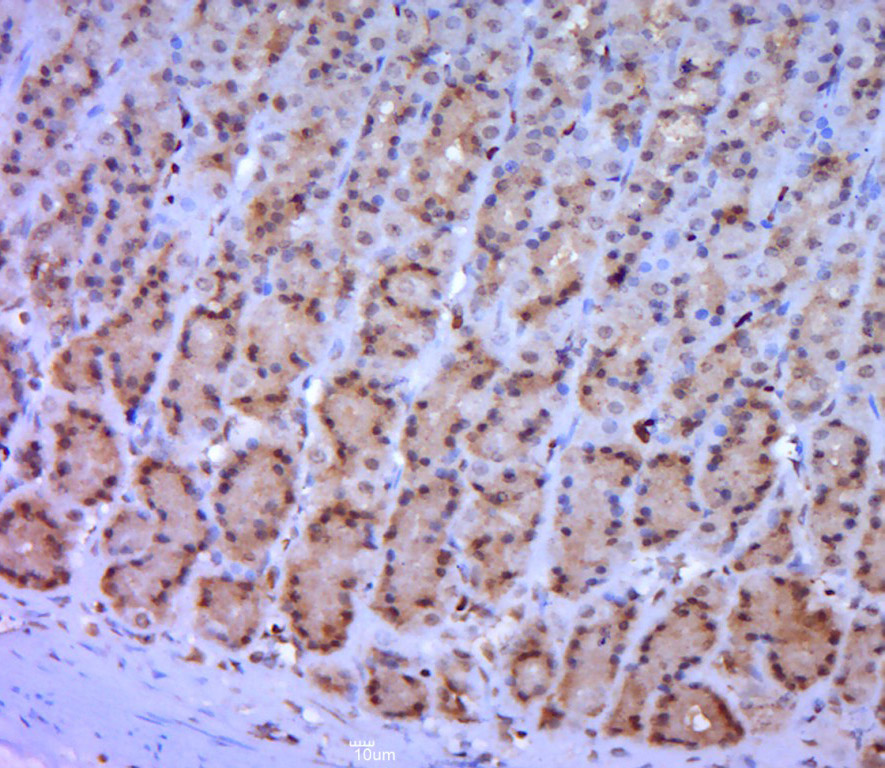
Rabbit Anti-Cryptochrome 1 antibody
Cryptochrome I; CRY1; CRY1_HUMAN; Cryptochrome 1 (photolyase like); Cryptochrome 1; Cryptochrome-1; Cryptochrome1; PHLL1; Photolyase-like.
View History [Clear]
Details
Product Name Cryptochrome 1 Chinese Name 隐花色素蛋白1抗体 Alias Cryptochrome I; CRY1; CRY1_HUMAN; Cryptochrome 1 (photolyase like); Cryptochrome 1; Cryptochrome-1; Cryptochrome1; PHLL1; Photolyase-like. Research Area Cell biology Neurobiology Signal transduction transcriptional regulatory factor Channel protein The cell membrane受体 Immunogen Species Rabbit Clonality Polyclonal React Species Rat, (predicted: Human, Mouse, Pig, Cow, Horse, Sheep, ) Applications ELISA=1:5000-10000 IHC-P=1:100-500 IHC-F=1:100-500 ICC=1:100-500 IF=1:100-500 (Paraffin sections need antigen repair)
not yet tested in other applications.
optimal dilutions/concentrations should be determined by the end user.Theoretical molecular weight 64kDa Cellular localization The nucleus cytoplasmic Form Liquid Concentration 1mg/ml immunogen KLH conjugated synthetic peptide derived from human Cryptochrome 1 : 181-280/586 Lsotype IgG Purification affinity purified by Protein A Buffer Solution 0.01M TBS(pH7.4) with 1% BSA, 0.03% Proclin300 and 50% Glycerol. Storage Shipped at 4℃. Store at -20 °C for one year. Avoid repeated freeze/thaw cycles. Attention This product as supplied is intended for research use only, not for use in human, therapeutic or diagnostic applications. PubMed PubMed Product Detail Circadian clocks are biological timepieces that regulate hormonal rhythms, sleep cycles and feeding behaviors. These rhythms are generated in the superchiasmatic nucleus (SCN), a cell-autonomous circadian oscillator located within the brain that is synchronized with the environment by light. A number of transcription factors, including Clock and BMAL1, are molecular components of the SCN that induce the expression of proteins involved in light/dark cycle entrainment, which include Per1 and Per2. Tim, for timeless, generates a negative feedback loop that regulates the activity of Clock by suppressing the expression of Clock target genes. Tim forms heterodimers with Per1 and Per2 that bind Clock and block the activation of Clock-BMAL1 dimers to repress Per gene expression. Additionally, the CRY proteins, which are cryptochrome photoreceptors for the circadian clock, function as light-independent inhibitors of the circadian clock. CRY1 and CRY2 negatively regulate SCN components by associating with the activators Clock-BMAL1, and also with the various feedback inhibitors Per1, Per2 and Tim.
Function:
Blue light-dependent regulator of the circadian feedback loop. Inhibits CLOCK NPAS2-ARNTL E box-mediated transcription. Acts, in conjunction with CRY2, in maintaining period length and circadian rhythmicity. Has no photolyase activity. Capable of translocating circadian clock core proteins such as PER proteins to the nucleus. May inhibit CLOCK.
Subunit:
Component of the circadian core oscillator, which includes the CRY proteins, CLOCK or NPAS2, ARNTL or ARNTL2, CSNK1D and/or CSNK1E, TIMELESS, and the PER proteins. Interacts directly with TIMELESS and the PER proteins. Interacts directly with PER1 and PER2 C-terminal domains. Interaction with PER2 inhibits its ubiquitination and vice versa. Binds MAPK. Interacts with FBXL21 (By similarity). Interacts with FBXL3.
Subcellular Location:
Cytoplasm. Nucleus. Translocated to the nucleus through interaction with other Clock proteins such as PER2 or ARNTL.
Post-translational modifications:
Phosphorylation on Ser-247 by MAPK is important for the inhibition of CLOCK-ARNTL-mediated transcriptional activity. Phosphorylation by CSNK1E requires interaction with PER1 or PER2. Phosphorylation at Ser-71 and Ser-280 by AMPK destabilizes it.
Ubiquitinated by the SCF(FBXL3) and SCF(FBXL21) complex leading to degradation.
Similarity:
Belongs to the DNA photolyase class-1 family.
Contains 1 DNA photolyase domain.
SWISS:
Q16526
Gene ID:
1407
Database links:Entrez Gene: 1407 Human
Omim: 601933 Human
SwissProt: Q16526 Human
Unigene: 151573 Human
Product Picture
Bought notes(bought amounts latest0)
No one bought this product
User Comment(Total0User Comment Num)
- No comment



 +86 571 56623320
+86 571 56623320
 +86 18668110335
+86 18668110335

